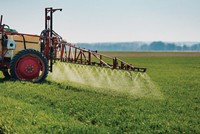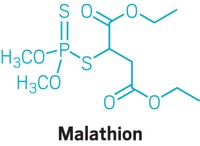Advertisement
Grab your lab coat. Let's get started
Welcome!
Welcome!
Create an account below to get 6 C&EN articles per month, receive newsletters and more - all free.
It seems this is your first time logging in online. Please enter the following information to continue.
As an ACS member you automatically get access to this site. All we need is few more details to create your reading experience.
Not you? Sign in with a different account.
Not you? Sign in with a different account.
ERROR 1
ERROR 1
ERROR 2
ERROR 2
ERROR 2
ERROR 2
ERROR 2
Password and Confirm password must match.
If you have an ACS member number, please enter it here so we can link this account to your membership. (optional)
ERROR 2
ACS values your privacy. By submitting your information, you are gaining access to C&EN and subscribing to our weekly newsletter. We use the information you provide to make your reading experience better, and we will never sell your data to third party members.
Pesticides
US EPA to revamp pesticide evaluations
Agency floats revised process for assessing risks to endangered species
by Britt E. Erickson
June 13, 2019
| A version of this story appeared in
Volume 97, Issue 24
The US Environmental Protection Agency is taking another stab at revising its process for assessing the risks of pesticides to endangered species. The move comes after manufacturers of three organophosphate insecticides urged the agency to abandon an approach established in 2015.
The EPA used the method to evaluate chlorpyrifos, diazinon, and malathion. During the final days of the Obama administration, the agency concluded that all three are likely to adversely affect more than 1,000 endangered species.

After pushback from the pesticide industry, the EPA is now proposing changes that would affect those determinations. Traditionally, the agency has used the maximum allowed usages stated on the pesticide label. Pesticide manufacturers claim that approach is overly conservative. The EPA now proposes evaluating risks using actual pesticide use data from various sources. Environmental groups argue that doing so would exclude from the analysis large geographical areas where no pesticide use data are available.
Also at issue is the need for the EPA to consult with the US Fish and Wildlife Service or the National Marine Fisheries Service, as the agency must do when it finds that pesticide use overlaps with the geographical area where an endangered species is found. The consultation is needed to determine whether the pesticide is likely to harm the species. Environmental groups have sued the EPA numerous times for failing to initiate such consultations. Hundreds of pesticides are scheduled for reevaluation over the next decade, and each of those could affect numerous endangered species. Federal agencies do not have the resources to conduct thousands of consultations in a timely manner.
Under the 2018 farm bill, the US Congress directed the EPA, the Council on Environmental Quality, and the Departments of Agriculture, Commerce, and the Interior to form an interagency working group to streamline the process. The group, which includes heads from each of the five agencies, met for the first time to discuss the EPA’s proposal on June 6.
Details from that closed-door meeting are scarce. “The Trump Administration is committed to carrying out the important responsibilities of the Endangered Species Act to protect and promote the recovery of species while recognizing that pesticides are a critical tool for protecting public health, supporting our farmers, and ensuring an abundant food supply,” EPA administrator Andrew Wheeler said in a June 6 statement.
The EPA heard mixed reviews about its proposal during a June 10 public meeting.
“EPA’s revised methods are an enormous step backwards,” said Brett Hartl, director of government affairs at the environmental advocacy group Center for Biological Diversity. Hartl claimed that the proposal deviates from 2013 recommendations by the National Academy of Sciences. The proposal also “abandons the collaborative and transparent work that the first biological evaluations represented,” he said, referring to the three organophosphate evaluations conducted under the 2015 method, plus two other evaluations that the agency never released for carbaryl and methomyl.
The proposal also limits consideration of pesticide drift to within 792 m (2,600 ft) of a treated field and pesticide runoff in water within 30 m of the site. “What happens if a pollinator of an endangered plant is exposed to a pesticide and killed, but that plant is more than 2,600 ft away from the treated field?” Hartl asked. “Under this approach, EPA is going to assert there is no effect.”
CropLife America, a trade group that represents the pesticide industry, supports the use of real-world data in the EPA’s evaluations, Manojit Basu, CLA’s managing director of science policy, said at the June 10 meeting. Such data better reflect where pesticides are used and target protection where it is most needed, he added.
The EPA is seeking feedback on its proposed changes until July 1. CLA has asked the agency to extend the comment period by 45 days because of the complexity of the issue.





Join the conversation
Contact the reporter
Submit a Letter to the Editor for publication
Engage with us on Twitter